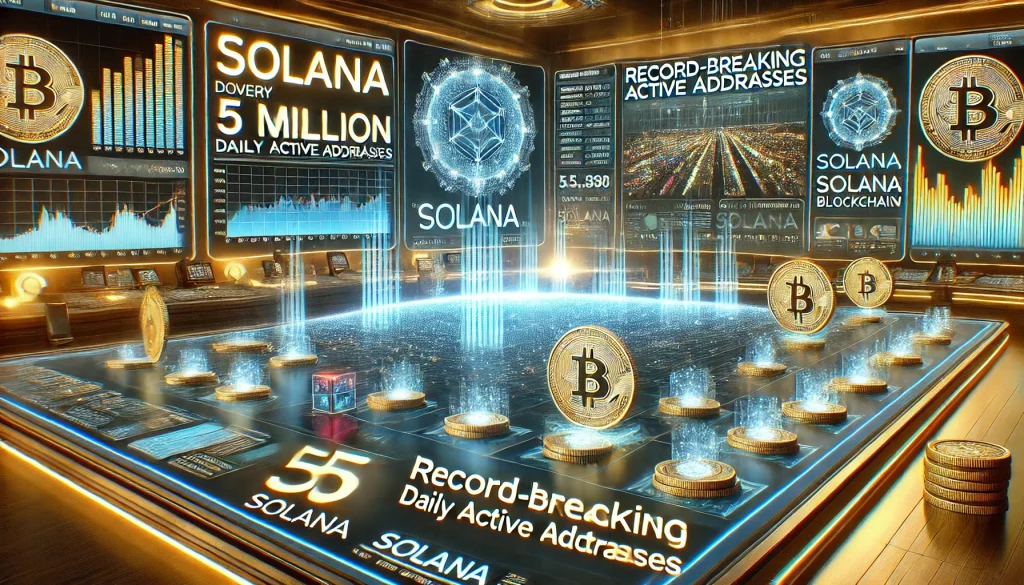Solana (SOL) has made headlines recently, breaking records for the highest number of daily active addresses on its blockchain, despite facing challenges with price volatility and a declining memecoin sector. On September 10, Solana recorded over five million daily active users, far surpassing its competitors, including Ethereum, which only had about 2.5 million active wallets on the same day. This achievement highlights Solana’s growing prominence in the blockchain space.
However, while Solana’s user activity continues to surge, its memecoin sector, particularly Pump.fun, has seen a dramatic decline, with revenues dropping by 80% since July. The question now is: how will these contrasting trends impact Solana’s future? In this post, we will explore Solana’s recent milestones, the challenges facing its memecoin sector, and what lies ahead for this fast-growing blockchain platform.
Solana’s Record-Breaking Daily Active Addresses
On September 10, Artemis reported that Solana had surpassed five million daily active addresses, setting a new record for the blockchain. This milestone underscores Solana’s increasing popularity and adoption as a high-performance blockchain platform. Despite fluctuations in SOL’s price, which was hovering around $136 at the time, the platform continues to attract more users than ever before.
The surge in user activity comes at a time when the broader crypto market is facing uncertainty. Bitcoin, Ethereum, and other major cryptocurrencies have experienced price slumps, but Solana has managed to grow its user base significantly. This growth is primarily driven by Solana’s scalability, low transaction fees, and fast confirmation times, making it an attractive option for both developers and users in the DeFi and NFT spaces.
The Decline of Solana’s Memecoin Sector
While Solana’s overall activity has surged, its once-booming memecoin sector has taken a sharp hit. Pump.fun, a decentralized finance (DeFi) platform that allows users to launch and trade memecoins, has seen an 80% drop in revenue since its peak in late July. At its height, Pump.fun was a massive success, generating $100 million in revenue in just seven months and allowing users to launch over 500,000 tokens in a single month.
However, the platform’s rapid growth may have been unsustainable. As the market became oversaturated with memecoins, speculative investors faced increased risks, with many losing substantial amounts of capital in the process. A crypto.news analysis found that fewer than 1% of memecoin traders earned over $1,000 from their speculative plays, while the majority saw their investments disappear.
Despite its decline, Pump.fun continues to produce new memecoins daily. However, its regression has led to concerns about the future of Solana’s memecoin ecosystem and whether this speculative sector is still a net positive for the Solana blockchain and DeFi as a whole.
The Impact of Pump.fun on Solana’s Revenue
The rise and fall of Pump.fun have had a noticeable impact on Solana’s overall revenue. Solana’s general fees and prices have slumped since July, coinciding with the decline in activity on Pump.fun. This correlation highlights the significant role that memecoins played in driving Solana’s transaction volume during Pump.fun’s peak.
At its height, Pump.fun contributed to an explosion of memecoin trading on Solana-based exchanges such as Raydium, where many speculative investors either made fortunes overnight or saw their investments wiped out in seconds. The protocol’s fast-paced, casino-like atmosphere allowed for massive gains, but it also created an environment of extreme volatility and risk.
Vitalik Buterin, Ethereum’s co-founder, and other key figures in the crypto world expressed concerns about the unsustainability of platforms like Pump.fun, questioning whether they aligned with the broader goals of decentralized finance. But despite the criticisms, Pump.fun remains active, albeit with a significantly reduced user base and revenue.
Is the Memecoin Trend Sustainable?
The decline of Pump.fun has raised questions about the sustainability of the memecoin trend on Solana and other blockchain platforms. While memecoins brought massive attention to Solana, they also introduced a high level of speculation and risk, which may not be conducive to long-term growth.
The oversaturation of memecoins has led to weaker average gains, as noted in recent analyses. With so many tokens flooding the market, it has become increasingly difficult for new memecoins to stand out and generate significant returns. As fewer traders profit from these speculative plays, interest in memecoins may continue to wane.
That said, Solana’s broader ecosystem, including its strong presence in DeFi and NFTs, offers a more sustainable growth path. The platform’s scalability and speed make it an ideal environment for developers to build innovative decentralized applications (dApps) that go beyond memecoins.
What’s Next for Solana?
Despite the challenges in the memecoin sector, Solana’s record-breaking user activity suggests that the blockchain is far from slowing down. The platform’s ability to attract over five million daily active users in a single day is a testament to its scalability and appeal. As Solana continues to grow, its focus may shift away from speculative assets like memecoins and toward more sustainable projects in DeFi, NFTs, and other blockchain-based applications.
Solana’s unique Proof-of-History (PoH) consensus mechanism gives it a competitive advantage over other blockchains, allowing it to process thousands of transactions per second with minimal fees. This scalability will be crucial as the platform seeks to expand its ecosystem and attract more developers and users.
In the near future, we can expect Solana to continue setting records for user activity, even as it navigates challenges like the decline of memecoins. The platform’s long-term success will depend on its ability to maintain scalability, attract new projects, and foster innovation across various sectors of decentralized finance.
Conclusion: Solana’s Future Looks Bright Despite Challenges
While Solana’s memecoin sector may be in decline, the blockchain’s overall trajectory remains upward. Its record-setting daily active addresses highlight the platform’s growing adoption and potential to become a dominant force in the crypto space. As Solana continues to innovate and expand its ecosystem, it is poised to play a key role in the future of blockchain technology.
For investors and developers alike, Solana’s strengths in scalability, low fees, and fast transaction speeds make it an attractive platform for building decentralized applications. As the broader crypto market evolves, Solana is well-positioned to navigate challenges and capitalize on opportunities for long-term growth.


